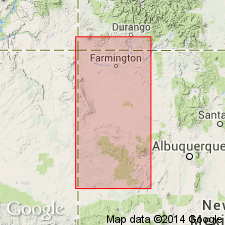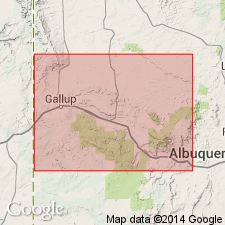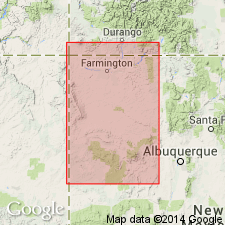
- Usage in publication:
-
- Torrivio Sandstone Member
- Modifications:
-
- Named
- Dominant lithology:
-
- Sandstone
- Shale
- AAPG geologic province:
-
- San Juan basin
Summary:
Named as the upper member of Gallup Sandstone for exposures on and around Torrivio Mesa about 8 mi west and southwest of Gallup. Type section (measured) is in SW1/4 SE1/4 NE1/4 sec 13, T15N, R18W in McKinley Co, NM in the San Juan basin. Is 55 ft thick at type where it overlies an unnamed dark gray, carbonaceous to noncarbonaceous shale of the Gallup and where it underlies carbonaceous and coaly mudstone of Dilco Member of Crevasse Canyon Formation. Upper contact easily mapped. Lower contact intertonguing. Consists at type of buff, red-pink, fine-, medium-, to coarse-grained sandstone and gray shale. The sandstone is well sorted, quartzose, feldspathic, irregular bedded to cross-bedded. Has angular, granule-size quartz grains, and some pebbles and cobbles. Ranges from 0 at pinchout near Smith Lake to more than 100 ft thick south and west of Gallup. Of fluvial origin. Genetically belongs with the overlying Dilco. Deposited by low gradient braided streams. Cross sections. Late Cretaceous age.
Source: GNU records (USGS DDS-6; Denver GNULEX).

- Usage in publication:
-
- Torrivio Member*
- Modifications:
-
- Redescribed
- Overview
- Dominant lithology:
-
- Sandstone
- Shale
- Siltstone
- Coal
- AAPG geologic province:
-
- San Juan basin
Summary:
Name revised from Torrivio Sandstone Member of Gallup Sandstone to Torrivio Member, the upper pink sandstone of fluvial origin. Distinguishable from other sandstones in the Gallup by its coarse grained texture. Consists of as many as three sandstones separated by interchannel carbonaceous shale, siltstone, fine-grained sandstone, and minor coal. Ranges from 0 to 100+ ft thick. Overlies unnamed part of Gallup; underlies Crevasse Canyon Formation. Cross sections. Thought to be younger eastward. Not known if member is time-transgressive. Age of member not stated specifically. Age of Gallup ranges from early late Turonian to early Coniacian.
Source: GNU records (USGS DDS-6; Denver GNULEX).

- Usage in publication:
-
- Torrivio Sandstone Member*
- Modifications:
-
- Revised
- Redescribed
- Dominant lithology:
-
- Sandstone
- AAPG geologic province:
-
- San Juan basin
Summary:
Removed from Gallup Sandstone and reassigned to lower part of overlying Crevasse Canyon Formation (revised) and is redescribed as the Torrivio Sandstone Member of the Crevasse Canyon. Torrivio is a fluvial sandstone unit that is genetically and lithologically very different from underlying marine tongues of Gallup. Torrivio is an irregularly bedded sandstone with variable grain size though is characteristically coarse grained and contains granules in lower part. The marine tongues of the Gallup are generally fine grained, very well sorted, and much more uniform in lateral extent. Torrivio is discontinuous along south side and is entirely absent on southeast side of San Juan basin. Fig. 2 shows Torrivio to overlie unnamed lower part of Crevasse Canyon in southwest part of San Juan basin; in northeast direction Torrivio shown to be discontinuous lenses surrounded by Dilco Member (redescribed) of Crevasse Canyon or, in places, to overlie tongues of Gallup. Principal reference for Torrivio remains the same as designated by Molenaar (1983). Late Cretaceous age.
Source: GNU records (USGS DDS-6; Denver GNULEX).
For more information, please contact Nancy Stamm, Geologic Names Committee Secretary.
Asterisk (*) indicates published by U.S. Geological Survey authors.
"No current usage" (†) implies that a name has been abandoned or has fallen into disuse. Former usage and, if known, replacement name given in parentheses ( ).
Slash (/) indicates name conflicts with nomenclatural guidelines (CSN, 1933; ACSN, 1961, 1970; NACSN, 1983, 2005, 2021). May be explained within brackets ([ ]).

